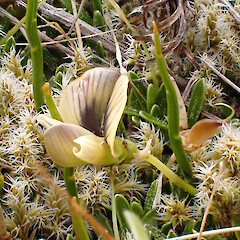Carmichaelia uniflora
Common name
Dwarf broom
Synonyms
Carmichaelia uniflora var. suteri (Colenso) G.Simpson; Carmichaelia uniflora Buchanan; Carmichaelia suteri Colenso
Family
Fabaceae
Flora category
Vascular – Native
Endemic taxon
Yes
Endemic genus
No
Endemic family
No
Structural class
Trees & Shrubs - Dicotyledons
NVS code
The National Vegetation Survey (NVS) Databank is a physical archive and electronic databank containing records of over 94,000 vegetation survey plots - including data from over 19,000 permanent plots. NVS maintains a standard set of species code abbreviations that correspond to standard scientific plant names from the Ngä Tipu o Aotearoa - New Zealand Plants database.
CRMUNI
Chromosome number
2n = 96
Current conservation status
The conservation status of all known New Zealand vascular plant taxa at the rank of species and below were reassessed in 2017 using the New Zealand Threat Classification System (NZTCS) – more information about this can be found on the NZTCS website. This report includes a statistical summary and brief notes on changes since 2012 and replaces all previous NZTCS lists for vascular plants.
Please note, threat classifications are often suggested by authors when publications fall between NZTCS assessment periods – an interim threat classification status has not been assessed by the NZTCS panel.
- Conservation status of New Zealand indigenous vascular plants, 2017 . 2018. Peter J. de Lange, Jeremy R. Rolfe, John W. Barkla, Shannel P. Courtney, Paul D. Champion, Leon R. Perrie, Sarah M. Beadel, Kerry A. Ford, Ilse Breitwieser, Ines Schönberger, Rowan Hindmarsh-Walls, Peter B. Heenan and Kate Ladley. Department of Conservation. Source: NZTCS and licensed by DOC for reuse under the Creative Commons Attribution 4.0 International licence.
2017 | At Risk – Declining | Qualifiers: DP
Previous conservation statuses
2012 | At Risk – Declining | Qualifiers: DP
2009 | Data Deficient
2004 | Not Threatened
Brief description
Very small (to 6cm tall) low-growing cushion with scattered erect small flattened twigs that barely poke above the surrounding vegetation. Twigs short, 1-2mm wide. Flowers usually solitary, pea-like, purple-striped. Fruit a small dry sharp-tipped pod which splits widely to release the 4-6 hard seeds.
Distribution
Endemic. New Zealand: South Island (Nelson, Canterbury, Otago, and Southland).
Habitat
Inhabiting stable but unconsolidiated, sparsely vegetated river bed gravels, outwash fans, terraces, and stony ground.
Detailed description
Dwarf, rhizomatous shrub, up to 20-60 mm tall and 1 m wide, forming a dense mat or tufts of cladodes. Rhizomes becoming increasingly stout and woody with age, 50.0-200.0 × 1.0-2.5 mm. Cladodes filiform, linear, striate, compressed, erect to spreading, green to green-yellow, glabrous, 20.00-60.00 × 0.75-2.00 mm; apex subacute, yellow to yellow- green; leaf nodes 2-14. Leaves simple, broad-obovate to broad-elliptic, fleshy, entire, green, present on seedlings, absent on mature plants, 5.5-8.0 × 3.0-5.0 mm; both surfaces with scattered hairs; apex emarginate to retuse; base cuneate to narrow-obtuse; petiole sparsely hairy, 2.0-2.5 mm long. Leaves on cladodes reduced to a scale, triangular, glabrous, 0.6-1.5 × 0.8-1.4 mm; apex acute. Inflorescence a raceme, 1 per node, each with l-2 flowers. Peduncle glabrous, occasionally sparsely hairy, green, 4-15 mm long. Bracts, triangular, glabrous, pale green, 0.5-0.8 × 0.5-0.8 mm; apex acute; margin hairy. Pedicel glabrous, occasionally sparsely hairy, pale green, 3.0-7.5 mm long. Bracteoles at top of pedicel, triangular to narrow triangular, glabrous, green and occasionally flushed red, 0.2-0.3 × 0.1-0.2 mm; apex acute; margin hairy. Calyx campanulate, c.2.5 × c.2.5 mm; inner surface glabrous, green; outer surface glabrous or sparsely hairy, green. Calyx lobes triangular, flushed red, c.0.5 mm long; apex acute; margin hairy or glabrous. Bud green. Standard obovate, patent, 8-10 × 6-8 mm; upper surface white, central area purple, sometimes purple-green veined; lower surface green, margin cream-green, sometimes purple-green veined; apex retuse; claw pale green, c. 1.5 mm long. Wings oblong, shorter than keel, 5.0-6.5 × c.2.0 mm; distal area of adaxial surface purple, proximal area green; abaxial surface white, sometimes purple-veined; auricle triangular, pale green, apex obtuse, c.1.25 mm long; claw pale green. Keel 6.0-8.0 × 2.5-3.0 mm; distal area of adaxial surface purple, proximal area pale green; distal area of abaxial surface dark, proximal area pale green; auricle triangular, pale green, c. 0.75 mm long, with obtuse apex; claw pale green, 2.0-2.5 mm long. Stamens 7.5-9.0 mm long; lower filaments connate for c. 2A length and outside filaments free for 1.5-2.5 mm. Pistil exserted beyond stamens, c.10 mm long; style with a ring of hairs below stigma; ovules 9-11. Pod elliptic-oblong, laterally compressed, weakly falcate, black, brown, or grey, one valve dehiscent from base, 7.5-13.0 × 3.0-4.0 mm; beak on adaxial suture, slightly upturned, stout, pungent, 1.5-2 mm long. Seeds oblong-reniform, 2-9 per pod, black, brown, tan, or olive green, 1.2-2.0 × 1.0-1.5 mm.
Similar taxa
Distinguished from C. corrugata Colenso by its narrower, thread-like rhizome; strongly dehiscent pod; cladodes which are narrower, thread-like, much less robust, often shorter, and green in colour; and by the usually single-flowered inflorescence.
Flowering
October - March
Flower colours
Violet/Purple, White
Fruiting
November - May
Propagation technique
Easily grown from seed and hardwood cuttings.
Threats
Probably threatened. However, there is insufficient data available to make an accurate assessment. It is known to be at risk from browsing animals and competition from weeds such as pasture grasses.
Etymology
carmichaelia: After Carmichael, a botanist
uniflora: Single-flowered
Attribution
Description adapted from Heenan (1995)
References and further reading
Heenan, P.B. 1995: A taxonomic revision of Carmichaelia (Fabaceae - Galegeae) in New Zealand (part I). New Zealand Journal of Botany 33: 455-475.
Thorsen, M. J.; Dickinson, K. J. M.; Seddon, P. J. 2009. Seed dispersal systems in the New Zealand flora. Perspectives in Plant Ecology, Evolution and Systematics 11(4): 285-309.






